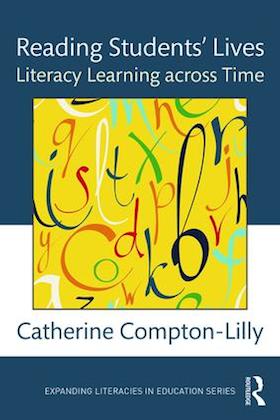Compton-Lilly Follows Students from First Grade through High School in New Book
March 2, 2017

Reading Students' Lives: Literacy Learning across Time
After two decades of research, Catherine Compton-Lilly’s latest book documenting the literacy practices and school experiences of a group of low-income, inner-city students and their families is now available.
“So much of the education research that’s done today looks at snippets of people’s lives,” says Compton-Lilly, a professor and highly regarded literacy expert with UW–Madison’s Department of Curriculum and Instruction. “But understanding how people live their lives and make sense of their world is not something you can get in a snippet. If you really want to understand other people’s experiences and ways of living we need longitudinal glimpses into who they are.”
“Reading Students’ Lives: Literacy Learning across Time,” does just that. This latest work from Compton-Lilly examines issues of schooling and how students and their parents make sense of educational experiences over the course of many years. The book follows a group of about 10 students from first grade through high school, bringing to the forefront issues and insights that are invisible in shorter-term projects.
When Compton-Lilly began this research project in 1997, she was a doctoral student at the University of Rochester, N.Y., and a first-grade teacher with eight years of experience working with children. Compton-Lilly explains that she was teaching in a school that served children from the lowest socioeconomic community of a city that had one of the highest rates of child poverty in the United States. The elementary school she worked at served more than 1,200 children -– and 97 percent qualified for free or reduced-price lunches.
“I was teaching these children to read,” Compton-Lilly says of her work as a classroom teacher. “I thought when I taught them to read that I was giving them access to a quality education and was opening doors to the outside world.”
But some of the students she worked with and followed as they moved from first grade, through middle school and onto high school, never graduated. Some were incarcerated.
“I feel passionate about telling their stories because there is a lot more going on in high-poverty, inner-city families than most people realize,” says Compton-Lilly, who was a classroom teacher for 18 years and arrived at UW-Madison as an assistant professor in 2004.
Compton-Lilly previously authored three books during earlier periods of this research: “Reading Families: The Literate Lives of Urban Children,” Teachers College Press, 2003; “Rereading Families,” Teachers College Press, 2007; and “Reading time: The literate lives of urban secondary students and their families," Teachers College Press, 2012. This final book in the series, “Reading Students’ Lives,” published by Routledge, follows the same children into high school.
“In many ways, this book isn’t particularly encouraging,” says Compton-Lilly. “A lot of the parents cared and were interested in their children’s education but they faced challenges. It was important to document their lives over time because I don’t think a lot of those challenges would have come across in short-term glimpses.”
Compton-Lilly notes that this most recent book in the series stands on its own –- as do the others –- so there is no need for readers to first digest the other publications before diving into this one.
Compton-Lilly says that one of the key takeaways from this latest work is the fact that inequities in schools are often persistent, structural and baked into the education system in disadvantaged communities.
“It’s important to realize that inequity in education isn’t one thing that happens to someone,” says Compton-Lilly. “What I argue is that for many of my students, it’s an accumulation of experiences over many years. Things like ongoing underfunding in their schools and not having access to textbooks. Or disproportionate punishments and suspensions from school for certain children. I also heard from people who reported a range of problematic interactions with teachers.”
Adds Compton-Lilly: “We as teachers and researchers need to be more aware of the ways in which experiences accumulate over time.”
Compton-Lilly says “Reading Students’ Lives” will be especially valuable to graduate-level students and education researchers as the longitudinal nature of the study provides a unique lens from which to view literacy practices, children, their families and schools. The publication provides empirical stories while breaking new ground both theoretically and methodologically.
In particular, the long-view nature of this research provides interesting insights into current conversations about literacy learning in underserved communities and highlights how children who have been historically underserved by schools can easily fall through the cracks of education systems.
Along these lines, Compton-Lilly says schools should consider designing and implementing practices and policies that allow educators to follow and build relationships with children over time. Developing these longitudinal relationships could help students better succeed. She adds, however, that these long-term relationships between educators, students and families must be characterized by trust, commitment and advocacy when needed.
“Schools often slice time horizontally,” explains Compton-Lilly. “Students are with one teacher in first grade, then go on to second grade and then third grade, and each time they get a new teacher -- and to a large degree, they have separate experiences. So there is not a lot of attention being paid to a child’s longitudinal being, and I think that’s problematic.”
To learn much more about these topics and Compton-Lilly’s research, visit this “Reading Students’ Lives” web page on the Routledge website.


